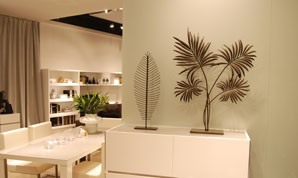Vietnam: Great opportunities, challenges lie in upholstery category
Source:Furniture Today
It’s also one of the largest categories still produced in China and one that is quickly shifting to Vietnam due to 25% tariffs on almost every type of residential furniture, seating included.
HO CHI MINH CITY, Vietnam — One of the major growth areas and opportunities for furniture manufacturers here is in upholstery. One of the most important categories for the U.S. market, it’s a segment of the industry that is relatively new to Vietnam.
It’s also one of the largest categories still produced in China and one that is quickly shifting to Vietnam due to 25% tariffs on almost every type of residential furniture, seating included.
According to import data, upholstered seats and chairs were among the top five exports from China in 2018, representing a combined $4.12 billion, or about 30% of the $13.5 billion in China furniture shipments to the U.S. that year.
Vietnam saw a 28% increase in upholstered chair shipments to the U.S. that year, but it was still a paltry $522.6 million. Upholstered seating still wasn’t even in the top five categories, meaning it, too, had a lot of room to grow in Vietnam, particularly in light of the shift that’s still occurring.
Furniture Today witnessed some of this shift during its tour of Vietnam factories in August. It was clear from the visit that factories are willing to take on more business as they expand their capacity in the upholstery segment, both stationary and motion.
But while there’s plenty of opportunity, there also are some major challenges including training workers as well as retaining workers in a tight labor market.
Probably the biggest examples of a major work-in-progress is motion furniture manufacturer ManWah Holdings’ 2.5 million-square-foot expansion of the existing 1.5 million-square-foot Timberland motion furniture plant it acquired last summer.
With the expansion, which broke ground last November and was completed around Aug. 1, a facility that before only shipped 170 containers per month was shipping 1,100 containers a month of finished goods by mid-August. This is expected to rise to 2,000 per month by the end of this year and 3,000 per month by early next year.
“ManWah needed capacity for the export market,” said Kevin Castellani, director of corporate communications, of the facility, which employed 3,000 in August, a figure expected to grow to 8,000 by next summer. “It has 20 million square feet in China, but we needed more capacity.”
Company Chairman Wong Man Li took ownership of the plant around the first of July 2018. The expansion broke ground in November, representing a $400 million investment in land, building and equipment, including new corporate offices, a new showroom, dorms and a new canteen for the workers.
“It was the right time and the right place, and Mr. Wong had the capital means to make a commitment to more than double the size of the facility,” Castellani noted. “And he invested a tremendous amount of money to get it done quickly.”
The expanded production area alone encompasses a massive seven buildings that are each five to seven stories high. There were 60 motion upholstery lines in place in August, and about 80 are expected to be in place by year end, Castellani said.
The campus not only produces finished goods, but also is a highly vertical operation in that it produces its own foam, motors, mechanisms and other components, including zippers. It also does its own product testing and has a raw materials warehouse that holds some $10 million alone in leather hides.
The plan is to have Vietnam produce good and better portions of the line. The upper part of ManWah’s motion line will continue to be made in China.
While ManWah’s expansion may be the largest, it is just one of many taking place now in the upholstery segment. Some factories have been ramping up for more than a year, partly in anticipation of the tariffs, but also to remain competitive in the stationary and motion upholstery segment overall.
China-based UE Chairs, which produces both office chairs and motion upholstery, began production in Vietnam earlier this year. It recently announced it is undertaking a $35 million addition to its existing plant, which will expand both sofa and office chair production.
For example, in the motion category, the expansion will double UE Chairs’ capacity from 250 to 500 containers a month of motion upholstery by the end of 2020.
Not just tariffs
Not all the shift is due to China tariffs. In fact the shift to Vietnam and other countries has occurred for several years. China not only has become more expensive due to rising labor costs. It also has faced tightening environmental regulations that have forced furniture producers to make the decision to move to other areas, including outside the country.
Some, such as Kaiser Furniture, ramped up their Vietnam production before tariffs, seeing the category as a growth area for its business.
Kaiser, which produces middle- to upper-middle-priced furniture, began operating its new 2.2 million- square foot plant — K2 — in 2018. This $100 million facility is in addition to the company’s estimated 3 million-square-foot wood, metal and upholstery plant — K1— also located in the Binh Duong Province.
The new plant also produces metal products, upholstery and wood furniture and plans to enter the motion business in 2020. Officials estimate it will produce about $120 million in wood, metal and upholstery per year.
While K1 already produced upholstery, officials said the company needed additional capacity for upholstery and metal furniture. K2 ultimately will have three upholstery production lines, including a second one that just opened in mid-September that will produce the motion line by 2020.The other produces stationary upholstery, and the third will handle both, said Charles Lo, CEO.
K2 also has one wood pallet finishing line and one hanging wood finishing line as well as a metal vacuum plating line, a metal powder coat line and a liquid plating line. Such vertical capabilities help produce both wood and mixed media elements that can be used throughout the line.
Shing Mark currently leases one of its facilities to Kuka for its motion line. But it also is building a new 1.2 million-square-foot upholstery plant that will be part of its 9 million-square-foot, 36-building campus in the Dong Nai Province.
An investment of some $20 million in building and new equipment, the operation will produce fabric and leather stationary upholstery in mid- to upper-middle price points, noted Victor Chao, chairman and founder. He expects by the end of this year it will be able to produce some 600 containers per month of finished product, which is in addition to the 1,200 container-per-month capacity for case goods and metal furniture on the existing campus. The upholstery plant also will be vertical in nature, producing its own foam, for example.
Wanek Furniture Co. also is expanding its upholstery production at its Millennium plant in the Dong Nai Province.
Currently producing mattresses and cut-and-sew kits, it has about 570,000 square feet of manufacturing and warehouse space, said Andrew Lien, general director of Vietnam operations.
This ultimately will expand to more than 1.3 million square feet of manufacturing and warehouse space by 2023, Lien noted, with additional capacity for both motion and stationary upholstery and case goods production. The total anticipated investment is expected around $130 million.
Over time, this will grow capacity to 3,000 containers per month, up from 180 containers per month, and boost employment from a current 1,800 workers to nearly 8,000.
“These facilities will allow us to continue to grow our manufacturing operations and fulfill the need of our expanding customer base,” Lien said. “We are shipping to more than 150 countries now as we continue to grow in Australia, New Zealand, China and other parts of Asia out of Vietnam.”
While not all expansions are directly tied to tariffs, others say they are indeed as customers are looking to resource.
High-end case goods and upholstery manufacturer Rochdale Spears, for example, is investing about $8 million in a new 350,000-square-foot upholstery plant nearby its existing manufacturing in the Binh Duong Province. The facility, set to open early next year with an unnamed customer taking up much of the capacity, will be able to make nearly $30 million to $40 million a year in middle to upper-end stationary upholstery, said Geoff Hawkes, CEO and co-founder.
This is up from the $8 million the company is already shipping in the category with products such as sofas, armchairs and sectionals for its Sonder Living line. Once these existing production lines move to the new plant, it will free up space in the company’s existing 1.7 million square feet of production facilities for additional case goods production, Hawkes noted.
Skilled worker challenge
Like others, Hawkes said that it could be a challenge finding skilled workers. But he said the company is ready to meet the challenge.
“Yes, it is difficult,” he said. “There are not a lot of upholstery workers, but we are putting in place (worker) training. We also are well-known in the marketplace and have been rewarded for that.”
Despite such optimism, developing upholstery in Vietnam could produce some headaches at least over the short term as workers new to the segment have to learn how to build to U.S. comfort and standards, particularly at the upper-middle end of the spectrum.
“The biggest challenge is upholstery: Vietnam is really not ready for good upholstery yet,” noted Angela Zhao, deputy general manager for Markor International Home Furnishings, which acquired an ownership stake in case goods and upholstery manufacturer Starwood Furniture Manufacturing in early 2018 and a stake in high-end case goods and accessories manufacturer Jonathan Charles around the same time. “Vietnam is making upholstery, but it is lower end.”
Markor has sourced in Vietnam for many years. Yet anticipating a greater presence in Vietnam, Markor set up a team there in the latter part of 2017 to begin a transition to better goods, both case goods and upholstery, but largely upholstery.
“We are sending more people here,” she said of Markor product development, production and engineering and even purchasing staff on the ground in Vietnam. “It seems that a lot of things in upholstery are not ready yet,” she added, referencing the need for higher grade fabrics and leathers for its middle to medium-high-end line.
As of August, it had sent about 50 Markor team members to help out particularly both the A.R.T. line as well as Jonathan Charles. Part of this is to educate Vietnamese staff on the ground about Markor systems and get set up for larger production runs. But it is also helping train workers to Markor’s quality standards, including finishing on the wood side.
In addition, the company has sent some Vietnamese workers and engineers from both Starwood and Jonathan Charles to its Tianjin, China, facilities to learn about Markor’s production there firsthand.
“It is not simply about investing money,” Zhao said. “That’s not going to work. The key is people. You have to have the cultures work together.”





 沪公网安备31010402003309号
沪公网安备31010402003309号



